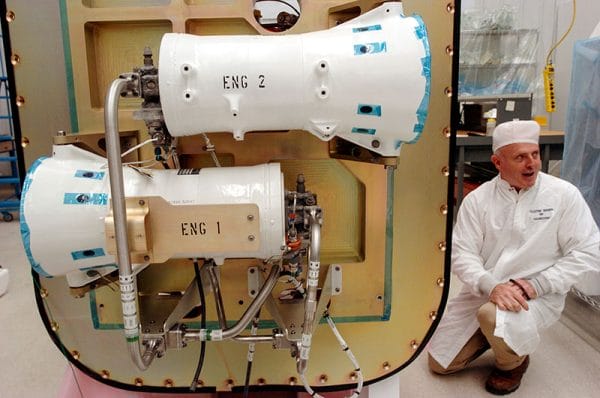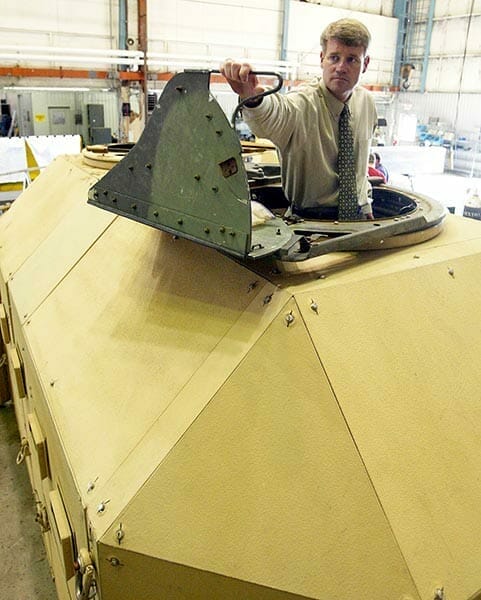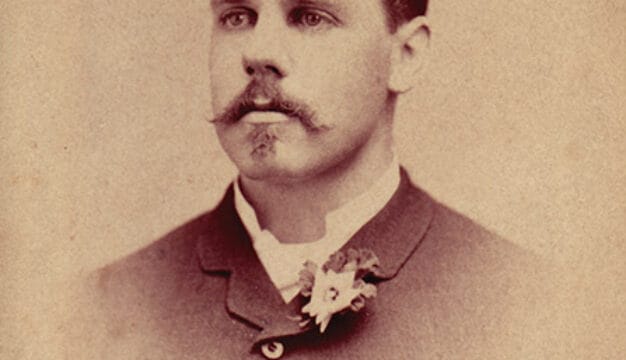Teledyne Brown Engineering
 Teledyne Brown Manufacturing
Headquartered in Huntsville’s Cummings Research Park, Teledyne Brown Engineering Inc., is a subsidiary of Teledyne Technologies, Incorporated, located in Thousand Oaks, California. The first high-tech firm to locate in Huntsville, Teledyne Brown Engineering has provided engineering and technology support to U.S. government space and defense programs since 1953 and later expanded into contracts for provide environmental and homeland security products.
Teledyne Brown Manufacturing
Headquartered in Huntsville’s Cummings Research Park, Teledyne Brown Engineering Inc., is a subsidiary of Teledyne Technologies, Incorporated, located in Thousand Oaks, California. The first high-tech firm to locate in Huntsville, Teledyne Brown Engineering has provided engineering and technology support to U.S. government space and defense programs since 1953 and later expanded into contracts for provide environmental and homeland security products.
Teledyne Brown’s history is closely intertwined with Huntsville’s Redstone Arsenal and Cummings Research Park. In 1950, Wernher von Braun and his team of German engineers and scientists were transferred to Redstone Arsenal to begin developing rockets for the U.S. Army. There were no engineering or manufacturing services available in Huntsville at that time. To meet that need, the local chamber of commerce recruited John Bolton, owner of Marietta Tool and Engineering, in Georgia to start a business in the city. Owned by local stockholders, Alabama Engineering and Tool Company opened on July 1, 1953. In 1956, the company merged with Brown’s Engineering, an Indianapolis firm, and was renamed Brown Engineering. That same year, the U.S. Army formed the Army Ballistic Missile Agency (ABMA), and Brown Engineering assisted it in developing the Redstone medium-range rocket and the Army’s first long-range missile, the Jupiter.
Brown Engineering also supported the ABMA’s revised mission to put a satellite in orbit following the launch of the Soviet Union’s Sputnik 1 on October 4, 1957. Under four months later, on January 31, 1958, the United States launched its first satellite, Explorer I, into space atop a modified Jupiter C launch rocket.
 Ares 1-X Roll Control System Module
In 1958, the company was taken over by a group of local investors headed by Milton K. Cummings. He had been a cotton broker and was known for his keen financial sense. Cummings, now major stockholder of Brown Engineering, was asked to be president. In that role, he quickly set the company on sound financial footing. That same year, Brown Engineering relocated into the Huntsville Industrial Center building. The larger facilities enabled the company to continue supporting the Army and increase its participation in the nation’s developing space program. William A. Giardini, an aeronautical engineer who joined the company when it first was formed, led the space efforts for 36 years.
Ares 1-X Roll Control System Module
In 1958, the company was taken over by a group of local investors headed by Milton K. Cummings. He had been a cotton broker and was known for his keen financial sense. Cummings, now major stockholder of Brown Engineering, was asked to be president. In that role, he quickly set the company on sound financial footing. That same year, Brown Engineering relocated into the Huntsville Industrial Center building. The larger facilities enabled the company to continue supporting the Army and increase its participation in the nation’s developing space program. William A. Giardini, an aeronautical engineer who joined the company when it first was formed, led the space efforts for 36 years.
Following the success of Explorer I, much of the nation’s space activities shifted from the military to a civilian agency, the National Aeronautics and Space Administration (NASA), which was established on October 1, 1958, by President Dwight D. Eisenhower. Then, on July 1, 1960, the NASA Marshall Space Flight Center opened at Redstone Arsenal, relocating many of those who had worked on the ABMA’s Explorer I mission.
In Brown Engineering’s efforts to support NASA as well as the Army, Cummings and vice president Joseph C. Moquin led the creation of a research park adjacent to the University of Alabama’s Huntsville campus. This area was eventually named Cummings Research Park in honor of Milton Cummings. In 1962, the company established its research laboratories headed by Raymond C. Watson Jr., a physics and engineering professor with wide industrial experience. The research operation supported Space Science Laboratories at Marshall as well as the Army’s emerging Ballistic Missile Defense Program at Army Missile Command.
Moquin assumed the duties of president in 1966 after Cummings stepped down. (Cummings remained chairman of the board for several years.) In 1967, Teledyne Incorporated of Los Angeles bought Brown Engineering. The company was renamed Teledyne Brown Engineering. It had approximately 3,500 employees and facilities in several states. Moquin continued as president of Teledyne Brown until 1985, remaining the CEO for four more years, retiring in 1989.
In 1996, Teledyne merged with Allegheny Ludlum, a Pittsburgh steel company. Three years later, this new firm was divided into three independent corporations, one of which was Teledyne Technologies, Incorporated. Teledyne Brown Engineering Inc., the engineered systems segment of Teledyne Technologies, is the largest of four units.
 Teledyne Brown Armored Vehicle
Teledyne Brown has achieved several notable accomplishments throughout its history. In the area of space exploration in the 1960s, Teledyne Brown provided about 20 million hours of work to the Saturn and Apollo programs, including engineering the Lunar Rover Vehicle and scientific planning for surface explorations on the Moon. In the 1970s, Teledyne Brown engineers were highly involved with the design of Skylab, the first U.S. manned laboratory in space.
Teledyne Brown Armored Vehicle
Teledyne Brown has achieved several notable accomplishments throughout its history. In the area of space exploration in the 1960s, Teledyne Brown provided about 20 million hours of work to the Saturn and Apollo programs, including engineering the Lunar Rover Vehicle and scientific planning for surface explorations on the Moon. In the 1970s, Teledyne Brown engineers were highly involved with the design of Skylab, the first U.S. manned laboratory in space.
In the 1980s, the company was a technical leader in the development and scientific operation of the Space Station, followed in the 1990s by the International Space Station. After the turn of the century, Teledyne Brown continued to work with the U.S. space program on key components of the Ares launch vehicles designed to return humans to the Moon and to someday explore Mars.
In support of national defense programs, Teledyne Brown Engineering operations in Alabama have worked on essentially all of the U.S. ballistic missile defense programs, including Nike-X, Safeguard (the first operational ballistic missile defense system), and the Strategic Defense Initiative (often called “Star Wars”). The company also works on the Ground Based Mid-Course Defense program to provide protection against foreign long-range missiles. Teledyne Brown’s air, space, and missile and ground warfare simulation software, Extended Air Defense Simulation, has more than 400 user agencies worldwide.
Manufacturing has always been a major focus at Teledyne Brown. The company’s Manufactured Products Group has more than 300,000 square feet of fabrication and assembly space. Included are two facilities in the Huntsville area. One builds nuclear hardware and assemblies and the other supports space flight and military hardware development. Teledyne Brown also fabricates mechanical and electronic products, ranging from prototypes and one-of-a-kind items to large-scale productions. Teledyne Brown’s three other business groups with activities in Alabama are: Air and Missile Defense Systems, Space Systems, and Chemical/Biological Systems.
 Lunar Lander Test
Company business is also conducted by a wholly owned subsidiary, Teledyne CollaborX Inc., operating in other U.S. locations. Defense systems capabilities and areas include missile defense and tactical weapon system engineering and integration, test range instrumentation; foreign material exploration; and site development and operations. Air and Missile Defense Systems primarily supports NASA, and their capabilities and focus areas include: engineering for space exploration, space station and shuttle operations, payload and cargo integration, space science and technology development, NASA facilities and equipment operations and maintenance, and space systems training. The Chemical/Biological group capabilities involve weapon system demilitarization; chemical biological agent detection and decontamination; radiological laboratory services; environmental compliance; chemical/biological threat reduction emergency management training; and facility design, operation, and protection.
Lunar Lander Test
Company business is also conducted by a wholly owned subsidiary, Teledyne CollaborX Inc., operating in other U.S. locations. Defense systems capabilities and areas include missile defense and tactical weapon system engineering and integration, test range instrumentation; foreign material exploration; and site development and operations. Air and Missile Defense Systems primarily supports NASA, and their capabilities and focus areas include: engineering for space exploration, space station and shuttle operations, payload and cargo integration, space science and technology development, NASA facilities and equipment operations and maintenance, and space systems training. The Chemical/Biological group capabilities involve weapon system demilitarization; chemical biological agent detection and decontamination; radiological laboratory services; environmental compliance; chemical/biological threat reduction emergency management training; and facility design, operation, and protection.



